THE TRADITIONAL INITIATORY PATH
One of the difficulties that I most notice whenever I am about to take the floor on subjects of an initiatory nature, is linked to the lack of a Sacred Language, as, in all probability, once upon a time, Humanity possessed, and of which today only echoes in languages such as Sanskrit and Hebrew, and hints in ancient sagas and legends. We, men of the Kali Yuga, are inevitably obliged to use profane language, even when we speak of the Sacred, and, consequently, to make our thought as intelligible as much as possible, we must work on the word, give it new meanings, force ourselves and force us not to think of a certain term in the way we are used to, in other terms, no longer being able to describe, we are forced to allude, that is to say, to express ourselves symbolically.
This is what I usually try to do when I communicate my reflections, even if this process inevitably weighs everything down, but, at least for now, I don’t see alternative solutions to the problem; I therefore entrust myself to the tolerance of the Brothers for some inevitable delays.
Even the title, which I have chosen for my work, The Traditional Initiatory Path, is misleading; how is it possible to put into words a concept which, although evidently unitary, manifests itself in threefold form? I almost envy those who solve the problem using dogma, my own conception of the subject appears to me terribly discordant, not so much with my thought, which, although undoubtedly confused, is still formal, as with my Intuition, which is not formal, and, it dissolves like snow in a blast furnace, when I try to rationalize it.
In this regard, the legend of Cupid and Psyche comes to mind, but I set out to trace, therefore, aware of my inadequacy, I return to earth, and begin to reflect on the first term of the trinomial, namely the Path.
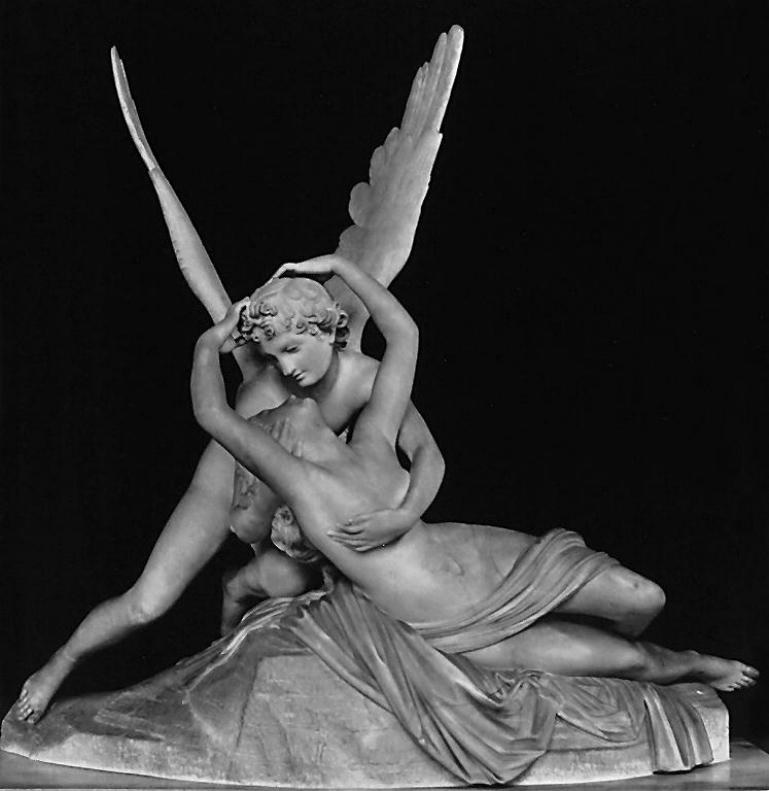
Cupid and Psyche, Antonio Canova, 1792
Apparently it would seem that the ordinary meaning of the term can satisfy our needs quite well, for example, the urban use of the term interprets the street as the space that connects separate places to each other, and we also use, correctly, the same meaning when again to give an example, let us consider the Path as what unites what is above with what is below; it is equally accurate to relate to the Path as to a discipline that one intends to follow, and, of course, other similarities can be noted, however, what I want to point out is that, in any case, the esoteric concept of the Path, while not excluding those previously described, in its essence, it differs somewhat from it.
In the meantime, I would like to bring to your attention a first observation, namely that from an etymological point of view this word implies a condition of absolute dynamism, the term is, in fact, connected to the Sanskrit vaha, in turn derived from vah with the meaning of moving, go.
Here, the dynamics, I believe, is the key to a correct understanding of the problem, let’s consider, in fact, a stationary point in space, suddenly, for its own reasons, passes from the static condition to the dynamic one, its own movement delimits the space that travels, in other words, I believe that the Path is not something antecedent to the man who travels it, if not virtually, it is, instead, the will to progress of the latter that makes the Path manifest.
Analogously, Man, passing from the condition of Profane to that of Freemason, comes out of the static state, let’s think of the condition of the Initiate, first closed in the Cabinet of Reflection, then, stopped in front of the Temple Door, to move on to the dynamism, symbolized by the Travels which he does inside the Temple.
Here, it is this dynamism that makes him intuit the Path, and, probably in a second time, he will realize that he will not be able to walk the Path if he himself does not become the Path. Therefore, contrary to the road, profanely understood, one cannot observe the route from a distance, estimate its length and evaluate its difficulties, since the Path has the curious peculiarity of being clearly visible only as regards the stretch covered, what is ahead is only intuitable.
We note the profound reversal of perspective we are witnessing, on the one hand, we have ordinary man who, being highly rational, uses the mind exclusively as a cognitive method, in other words, using terms more familiar to us, here thought is the male who penetrates Nature to know it, but, and here we turn, for a moment, a thought to the biblical concept of knowledge, we have, on the other hand, the Initiate, for whom the mind is female and knows by letting itself be penetrated.
And here, perhaps, my reference to Cupid and Psyche becomes clearer, let’s think of the Opera, it, passive, subjugates, needs a support, the thalamus, in fact, to sustain itself, is absolutely dependent on him who barely touches it , its movement is entirely aerial, their faces, within the circle of Psyche’s arms, remind me of an hourglass, where, clearly, what is above descends to fertilize what is below, and, if you want a Another image, you can think of a hummingbird pollinating a flower.
Both representations help me understand the mechanism by which intuition manifests itself in the mind, which can do nothing but contemplate. At this point it is easy to understand both the superiority of intuition over reason, and the need for the Initiate to fix the intuitive capacity in the mind, an action which, as legend teaches, cannot, however, be performed by this last. I would like to go deeper into the topic, but time is running out, and I have to go back to the Tracing. At this point, I would like to underline another aspect of this path, which some say is:
thin as a blade of grass and sharp as the blade of a sword
to indicate not only the difficulty, but also the danger, both made even more accentuated by the fact that the Path, not only does not provide for the return, but, in which, the proceeding must be constant, under penalty, not only failure, but , as a rule, spoils it.
To help understanding, I invite the Brothers to consider the action, this time physical, of common walking, one starts from a position of balance and moves the leg, and the weight of the body, forward, this is a deliberate imbalance which it will cancel once the movement is finished, but if, before this happens, the step stops abruptly, a little as happens, when we stumble, we would find ourselves exposed to the risk of falling. Or, let’s assume we lift a heavy suitcase above our head, to be able to introduce it into a compartment, if it escapes us, when we are in maximum extension, there could be trouble, but if we succeed in the desired maneuver, all effort ceases, and we can enjoy the advantage of the conquered position.
In conclusion, the path cannot be undertaken for fun or out of curiosity, it is necessary to be really motivated, willing to face hardships and dangers, I recall, in passing, that the Golden Apple Tree grows in the Garden of the Hesperides, but also that it is well guarded.
But let’s go back to the Tracing, I said that the term Path implies movement, and, sorry for the banality, but this is one of the characteristics of the living being.
The Freemason comes to light with Initiation, we could say after the gestation in the four elements, but this is another matter, which we will do, if you like, another time, the one I am anxious to emphasize today instead , is that, there is no doubt that whoever is born exists, obviously on this level, but, if he remained an infant throughout his life, perhaps he would live a pleasant and peaceful life, but, certainly, he would not become a man, in other words he would not accomplish what Nature required of him.
Similarly, Freemasonry asks each of us to follow the Traditional Initiatory Path, but, aware of the importance of free will, leaves each Brother the faculty to follow his own inclinations, whatever they may be, as long as they are contained within the Landmarks, even if, coherently with its purpose, it admonishes and indicates the path that must be followed in order to be truly Freemasons and not mere members of Freemasonry.
I wanted to make a final consideration using the symbol of the cross, the Greek one to be clear. Even the ordinary man is endowed with inner movement, we certainly cannot deny the intellectual, moral, emotional, and certainly also spiritual aspects that are found among the laymen, however, I believe that such movements should be understood only on a mental level, therefore earthly, related, symbolically, to the horizontal stroke of the cross, vice versa, verticality is the prerogative of those who really move in the spiritual dimension.
There are many ways to define it, and all of them are obviously incomplete, since, as I mentioned at the beginning of the Tracing, on the one hand we do not have a suitable vocabulary, and, on the other, in any case, with words, which are the prerogative of the mental, it is not possible to describe certain realities, which we can only reach through the Symbols.
In this context, I offer you an image that I consider particularly suggestive, verticality is presented here as one:
Golden chain that binds men to their divine origin, which preserves and transmits all that is necessary to walk the path that leads to the Light
Symbol that allows me to hypothesize two currents, let’s call them that, one ascending and the other descending, let’s say concentric, even if in reality I conceive a bidirectional movement along the same axis, impossible in the physical world, and corresponding, from one side to the the ascent of the Being, by virtue of Initiation and on the other hand to the descent of the Spiritual influence which emanates from the One, in other words from Tradition.
We can recall, in this regard, the symbolism of Jacob’s Ladder
And here is a ladder leaning on the earth, the top of which touched the sky; and behold the angels of God ascending and descending the ladder (Genesis 28,12).
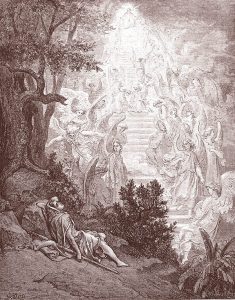
Gustave Doré 1874
In conclusion, it appears evident that, from this perspective, the terms tradition and initiation do not describe rigorously separate concepts, but mutually integrated ones.
Therefore, taking a step back, it is first of all necessary to get out of Dante’s sleep, which is the profanity of ordinary man, and therefore it will be possible to acquire the intuition of verticality, i.e. to have inner awareness, in other words not mental, of a different and superior mode of existence to the current one; at this point, it will be sufficient to adapt to what Nature foresees for our evolution, in other words to operate on ourselves according to the Tracing of the G:.A:.D:.U:.
Let us try to clarify these concepts better.
The role of Masonry Initiation is to place Man in the Middle, in other words, at the crossroads of the axes, that is, to place him metaphysically in that unique and privileged point, which allows Man to evolve, but, attention, also, theoretically , to involve, i.e. to proceed in a counter-initiatory sense. The dangerousness of this really crucial point was well known to the ancients, an example for all, in medieval demonology, a topic whose prudent study I would suggest, Satan was placed at the crossroads.
Now, it being understood that it is easier for Man to descend than to ascend, the nature of the true Freemason can only be ascending, to the point that the Cross transforms into an inverted Tau, the descending trait has disappeared, it does not belong to us. and we don’t care. From this perspective, it is evident that the Golden Chain is not a symbol of slavery, but of freedom, since it allows Man to free himself from the servitude of Matter; to give another example, we can consider it a rope which, similarly to those used in mountaineering, prevents us from falling into the abyss, even if it is probably more correct to consider it a sort of Filo d’Arianna, in other words as an element that it allows us to fulfill our destiny.
Ultimately, the Tradition constitutes an emanation of a very particular type of Gnosis – so elevated and complete, that it cannot be imagined, I am not saying a superior one, but not even equal – which proceeds from the spiritual to the material level. If we admit that the true spiritual center resides – so to speak – in the non-manifested and that this is absolute Power, then what we know, that is the manifested universe, can only be one of the innumerable implementation possibilities of the Center. Furthermore, it seems plausible that this manifestation is not only contingent and provisional, but that it exists solely as a continuous irradiation of the non-manifested. To make an analogy, my thought about an object persists as long as my mind turns to something else; therefore it is not surprising that, according to Guenon, Tradition is the transmission of the idea of the Supreme Being, in its absolute perfection, and of all its emanations, including, obviously, Man. This idea, due to its nature, can only always be the same as itself; those, which some may perceive as modifications, actually constitute nothing more than an adaptation to the circumstances, an event that is far from remote. On the contrary, Tradition, far from being an obstacle to the adaptations that circumstances require, has always provided the adequate principle of all those which have proved necessary. Even if Tradition is apparently transmitted from man to man, it is more correct to consider it a theophany: in fact, traditional knowledge has never belonged to this or that individual, and the peculiarities of those who have exposed and interpreted them have a very secondary importance. In other words, in order to speak of the transmission of Tradition, the intervention of a non-human element is indispensable.
It is undoubtedly a concept that is difficult to understand, at least for the person speaking to you; in fact, I am deeply convinced that to know something, from an initiatory point of view, it is necessary to become the thing itself, which makes it virtually impossible for a human to realize the knowledge of the non-human. On the other hand, ignoring the non-human element is properly disregarding what is the very essence of Tradition. This obviously makes intelligible the lack of understanding, by the majority, of the true nature of Tradition, which is a clear sign of the current process of degeneration of our Society. Consequently, everything that is inspired by traditional knowledge always proceeds from within and not from the outside of the Being. This element obviously makes the approach to Tradition not inaccessible, but difficult to implement, in particular as regards its truly profound aspects. In conclusion, the manifestation manifests itself again with a sort of cyclicity: on the one hand the so-called creation continuously creates the medium within which the spirit of the Initiates evolves and on the other hand the Tradition, with the consequent Initiatory Path, allows these the return to the Heavens.
As initiates, we are informed of the existence of a variety of events which allow, if not the sure attainment of such knowledge, at least the attainment of the ideal conditions which favor the occurrence of Intuition, in other words, of that faculty which allows to get in touch with one’s inner Self, the true medium for the Absolute Truth.These, which I have defined as events, since I don’t know better how to define them, are, of course, an integral part of the Tradition.
I try to clarify my thoughts, I previously stated that Tradition is the knowledge of the Absolute, and, in my previous interventions, that the Divine is simultaneously inside and outside of Us, simply the ordinary state of Man’s Consciousness is not able to perceive it, being completely, or almost, absorbed in Matter, this condition is so strong that in most cases, it entirely conditions the existence of the individual.
Therefore, as far as Freemasonry is concerned, certainly Rites and Symbols, for those who follow the Via Umida, particular prayers, some sacraments, certain liturgies, for both Paths, meditations, styles of vines conforming to the Research undertaken. I talked about lifestyles, it may seem like a fussy detail, and perhaps it is, personally, however, I don’t believe that one can walk the Initiatory Path two or three hours a week, it is certainly a principle, but, deliberately, I keep repeating myself , the only way to walk the Path is to become the Path, in other words you have to work 24 hours a day, always. Which does not mean that we need to chain ourselves to the top of a column, this would be the antithesis of our freedom of thought and action, but, in any case, it is a question of creating a quid which is already very difficult to understand.
Therefore, if it is certainly true that we need to sanctify every moment of our lives, since man’s intuition is to be sought through every human act, we still need to understand what is meant by the term sanctify.I realize that it is a difficult and personal speech, in an attempt to help form one’s own opinion on the matter, it seems to me very useful to quote Robert Louis Stevenson:
Don’t judge each day by the harvest but by the seeds you plant
It is undoubtedly a distortion of the ordinary way of thinking, we could venture that what matters is not the result, but the correct action, whether the goal is achieved, at this point, is indifferent.
I would now like to give a couple of examples of sacred activity, which I personally find particularly suggestive.
The first concerns Kyudo, the Zen art of the Japanese asymmetric bow, here the target can also be placed one meter from the archer, since what matters is not hitting the external target but the internal one, it is no coincidence that it is stated that the action of drawing the bow brings about the union of Heaven and Earth, and consequently the archer becomes a Middle Man, allow me a parenthesis, I will certainly be biased, but it seems to me difficult not to see a compass in the bow , and a team in the tightrope, on the other hand in Kyudo bow and arrow are intended as instruments of spiritual work, it is no coincidence that the motto of the Art is:
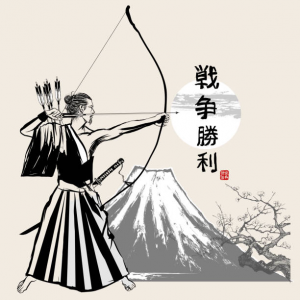
One arrow… one life
The second example that I would like to offer you is provided by the Tibetan Monk while building the Mandala, which we can understand, with a certain approximation, a symbolic synthesis of the cosmos used, mainly but not exclusively as an aid for meditation, then destroys it, suggesting that the The universe exists only to allow us to discover its spiritual essence, recreating the cosmos means participating in the sacred, and it had to be likewise for the builders of cathedrals, the object of the work, once again, becomes an absolutely secondary support with respect to the spiritual growth of the ‘Artist.
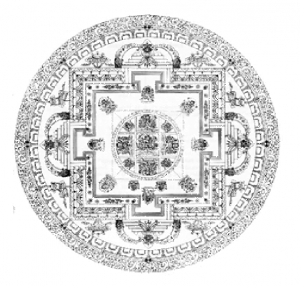
In this perspective, each of us must try to act like a Little Demiurge, that is, to infuse the essence of our divine nature into daily life, since, as Plotinus admonishes:
It is necessary to make oneself similar to the gods… and not to (albeit) good men
In other words, and this is a tremendous difficulty, it is necessary to act in accordance with Nature, i.e. understand: What is above and analogically reproduce it in What is below.
But let’s go back to the Tracing, the third aspect of the vertical stretch of the Tau is the one more properly connected to Initiation; obviously, a discussion, I’m not saying exhaustive, but also simply clarifying of this topic, would require, at least, a volume, for which, having already premised that the Initiatory Path substantially consists in first becoming aware of the super-human modalities of existence, and, therefore, of the non-human ones, I will limit myself to dealing with those aspects that I consider most important.
So let’s start by saying how such experiences can be had, let’s start ab ovo, that is, from that silence which, already imposed on the Apprentice, returns, in a more complete form, with the Secret Master; here, the experience of Inner Silence, i.e. the suspension of mental processes, leads the initiate to the awareness of his own nature (to use a Masonic terminology: to the Light) which, in any case, is not a concept that can be translated into words, since with the manifested (and the human word is such) the non-manifested cannot be made intelligible. Also because, it should be noted, living this experience means existing in a particular state of consciousness, very different from the ordinary one, in which our awareness behaves like a mirror, that is, it reflects impassively and silently, devoid of dichotomy between the contemplating subject and contemplated object, when we come out of this condition, we clearly keep within us the knowledge of that experience, it is true, but, I want to clarify that this particular Gnosis cannot be translated into thought, and least of all, into words, not even for those who have lived in fact, only by returning to that condition will he be able to relive this state.
Here we are able to understand the true and most intimate meaning of the terms Esotericism and Secret, in other words: the first, which can be related to an individual inner experience, and the second, to an experience that cannot be verbally transmitted.
At this point it is easy to realize that we are not our mind and that, for the Initiate, the physical death that will drag our mental structure with it will not represent the end but only a new beginning.
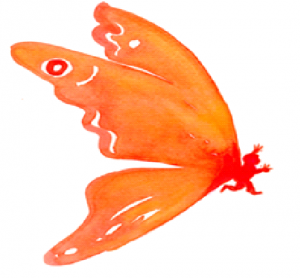
you do not realize that we are worms
born to form the angelic butterfly
( Dante, Purgatory, Canto X)
Every adult has been a child, but in him there is nothing left, or almost nothing, of that child, in some respects, he is dead, as his sensitive form, both physical and mental, have irreparably disappeared, and yet we exist, this makes it easier to understand the saying that it is necessary to die, in the current state, to be reborn in another, clearly more evolved.
From this point of view, the monastic invitation:
Brother, remember that you must die!

It can indicate, not so much the precariousness of our existence and the ineluctability of the end, but, esoterically understood, the need to realize the indispensable condition for becoming true Initiates.
I have finished for this evening, I could say that the Tracing is concluded, but basically it would not be correct, I believe, in fact, that the Freemason writes only one Table in all his earthly life, where he notes, from time to time, the different aspects of the Inner Work he does, and since, as far as I’m concerned, much is missing from the conclusion of the Work, I prefer to say that the Route is suspended.